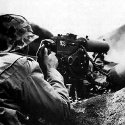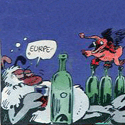|
Boiled Water posted:How does war, which from my point of view is pretty messy already, get to be described as messy? As in very little static lines of defense, lots of envelopments and pocketed forces, pretty much a big cauldron of 'red' and 'blue'. EvanSchenck posted:Do you have any more detail about this anecdote? The meaning of it would seem to depend a lot on context. Yeah I'm a bit reserved about it as well, let's just leave it in the middle since I can't even find the quote again. You can see a definitive swing towards limited and even defensive operations in WP exercises towards the end of the '80s but that's a bit outside the timeframe of any conflict realistically happening. EvanSchenck posted:I'm not sure how this works. Even if the southern forces under American command are able to hold the line against the forces initially disposed against them, how would they keep it up as Soviet forces to the north turned down the Rhine and added a second axis of attack? I'd wager CENTAG would have had a much better chance in the initial phase. First of all the terrain is much more conductive in NORTHAG's sector, north of the Mittelland Kanal in particular. From there on south it gets worse, even along the Salzgitter - Hildesheim - Hameln axis there's a lot of nasty terrain to cross, not to mention both the Weser and the Leine in some relatively hilly areas. From Kassel onwards (and the start of the 3. Korps area, CENTAG's northernmost) everything turns to poo poo for the attackers, with many hull-down and ambush positions along ridge- and treelines for defending forces to exploit. Of course there's the axes around the Vogelsberg (and I'd rather slog through the faultline between the 3. Korps and V Corps towards Giessen than get bogged down near Fulda) and the lesser known 'Hof Gap' but you'd get your nose bloodied there. Further towards the West there's the Odenwald, Taunus and Rothaargebirge /Sauerland to cross if you're the unlucky commander of the 8th Guards army of 1st Guards Tank Army (mislabeled on the map). In the north there's only the Weser and, potentially troublesome, the Teutoberger Wald southeast of Osnabrück. Form there on it's one big funnel towards the low countries: everything above the line Bremen - Antwerp is insignificant towards any goal of enveloping southern forces (save for trying to knock out the Dutch, although the army might want to fight on) and to the south you've got, again, the Sauerland and possibly even worse conditions in the Rhein-Ruhr area. Like this. I've seen it happen time and time again, both in the HPS Modern Campaign series and multiple TOAW scenarios: relative standstill in the south, rapid penetration in the north at H48-72. I guess Ralph Peters was on to something when he ended Red Army with the W. Germans giving up because of both the US and the UK pushing for a nuclear release, assuming of course that the conflict would have started off non-nuclear. A huge caveat. EvanSchenck posted:What impact do you think followup forces from the second line of Warsaw Pact states might have? AFAIK for NATO the forces on your map plus the independent French army was everything that could be expected to make a serious contribution, whereas secondary Warsaw Pact states maintained armies that, if not up to Soviet standard, were still relatively large and well-equipped compared to, say, Greece or Portugal. Do people wargame stuff like Hungarian divisions pushing through Austria into Venezia against Italian resistance, or Bulgarians and Romanians taking on Turkey and/or Greece? I guess they do wargame it but it's still a sideshow compared to the big standoff, I guess that's why HPS released three Panzer Campaign titles in the NATO v WP headliner in Germany mold and not, say, Thrace 1985 or Friuli 1985  The availability of follow-on forces all depends on the timetable for the attack. If there hadn't been more than a couple of weeks of preparation, scratch all cat. B and lower WP divisions. There's talk going around of the Soviets not trusting the East Germans to enter their western neighbours in the first echelon (ready divisions of the GSFG minus the 20th GA probably) and more talk about them not trusting the Poles to remain on home soil. EvanSchenck posted:Equipment would vary according to what year you're talking about. You'd even have four top of the line tank divisions slugging it out with the Brits across the Mittellandkanal with older equipment slowly crawling at V and VII corps. From their order of battles you can clearly see the Soviets favored the North German plain. Koesj fucked around with this message at 16:25 on Feb 8, 2011 |
|
|
|

|
| # ? Jun 9, 2024 22:04 |
|
I've got me a hankering to learn a little bit about WW1-era small unit tactics or the lack thereof, whichever may be the case. Can you guys direct me to any sources that talk about the differences between Russian, German, and Western Entente organization at the squad to platoon level?
|
|
|
|
Grand Prize Winner posted:I've got me a hankering to learn a little bit about WW1-era small unit tactics or the lack thereof, whichever may be the case. Can you guys direct me to any sources that talk about the differences between Russian, German, and Western Entente organization at the squad to platoon level? The British didn't even acknowledge platoons existed until a few years into the war, heh. Anyway, there aren't a lot of books written specifically on this topic, but it is covered in some detail in most good writings. This is widely considered sort of a defacto standard, and it is a good resource though somewhat dry, Forged by Fire is a good read and a pretty good analysis though it goes a lot deeper than just tactics.
|
|
|
|
Can someone give me a brief rundown on what Austria Hungary did in WWI besides just simply get its rear end kicked?
|
|
|
|
From what I remember reading about WWI (A World Undone is a wonderful book and everyone should buy it), a lot of what they did was one step forward and two steps back. Unfortunately I can't remember any specifics other than Conrad von Hotzendorf generally screwing up everything and yet retaining command. Later in the war he got the bright idea to swing around and invade Italy, which started well until he forgot that most of his troops had died already.
|
|
|
|
Shimrra Jamaane posted:Can someone give me a brief rundown on what Austria Hungary did in WWI besides just simply get its rear end kicked? The alpine fighting between Austria-Hungary and Italy was pretty brutal. If you go to the old battlefields/mountainsides you can see old foxholes and stuff. It's a shame that not much is written on it, and not much is likely to.
|
|
|
|
A lot of guys were killed by artillery induced avalanches, IIRC.
|
|
|
|
Italy wasn't the greatest adversary either, if I recall, they tried invading the same valley like 9 times and failed at it every time.
|
|
|
|
Shimrra Jamaane posted:Can someone give me a brief rundown on what Austria Hungary did in WWI besides just simply get its rear end kicked? It resulted in "The Good Soldier Svejk", so overall it was all good. Jaroslav Hasek himself was captured by Russians, and became a bit of a communist, I think. But many of his countrymen weren't as favorable with the Bolshevik revolution, resulting in the Czech legion controlling half of Russia (ie. mostly Siberia) as they wanted to get back to the newly formed Czechoslovakia but the communists wanted to disarm them. Technically not WWI, but important part of the aftermath! Nenonen fucked around with this message at 03:42 on Feb 9, 2011 |
|
|
|
Saint Celestine posted:Italy wasn't the greatest adversary either, if I recall, they tried invading the same valley like 9 times and failed at it every time. How did they keep selling that to the men? "We're gonna do it this time guys, I swear! Now CHARGE!"
|
|
|
|
Reading On Killing by Dave Grossman, a book that I think was recommended in this thread. Goddamn is it interesting. There's a quote by Leo Tolstoy right at the start which explains the subject matter quite well "War has always interested me; not war in the sense of maneuvers devised by great generals, but the reality of war, the actual killing. I was more interested to know in what way and under the influence of what feelings that one soldier kills another than to know how the armies were arranged at Austerlitz and Borodino." While it talks mostly of soldiers in modern wars, it does include stuff like bayonet charges in napoleon times and how the unit structure of the roman army enabled them to kill so well.
|
|
|
|
Boiled Water posted:How does war, which from my point of view is pretty messy already, get to be described as messy? edit: \/ What was the desertion rate like, compared to others in the area? Revolvyerom fucked around with this message at 07:31 on Feb 9, 2011 |
|
|
|
Shimrra Jamaane posted:How did they keep selling that to the men? They actually tried it 12 times averaging one every three months, and they sold it to the men by pressing a gun to their necks.
|
|
|
|
Nenonen posted:Jaroslav Hasek himself was captured by Russians, and became a bit of a communist, I think. But many of his countrymen weren't as favorable with the Bolshevik revolution, resulting in the Czech legion controlling half of Russia (ie. mostly Siberia) as they wanted to get back to the newly formed Czechoslovakia but the communists wanted to disarm them. The oft-cited American presence in post-war Siberia was there specifically to facilitate the Czech Legion's return. Well, that and to keep the Japanese from just simply gobbling up the entirety of Eastern Russia. Kind of ironic, since it's often used as a justification for Bolshevik belligerence towards the US.
|
|
|
|
Shimrra Jamaane posted:Can someone give me a brief rundown on what Austria Hungary did in WWI besides just simply get its rear end kicked? Everything they touched was pretty awful for everyone concerned and none of it gets a lot of attention. They did three main things: 1) Beat up on Serbia. By "beat up", I mean "attempted to eradicate". Serbian casualty numbers were astonishing: in absolute terms they were about half that of the British, despite Serbia's being ten times smaller. Well over half of the male population of the country was killed, and almost two thirds of their military. This was through battle, assorted massacres (especially by the Bulgarians, who had a bit of a bone to pick with the Serbs), and what was probably the worst typhus epidemic in human history. The A-H military suffered similar battle casualties in numeric terms. 2) Slapfight with the Russians in the East. Interestingly, for most of the war A-H and German troops fought under a single command, and we're pretty familiar with what they did to the Russians. The majority of the A-H army was here (something like 100 of 200 total divisions). 3) The ugliness in the Alps. This is one of the most bizarre and interesting episodes of the war and very little is written about it. There were essentially two major episodes: - The Isonzo/Soca battles, which was Italy's primary offensive effort during the war. This was just Italians charging over and over into fortified Austrian positions in the Alpine foothills and boy did it go well. - The battles in Tyrol. These were smaller in scale but it sounds unbelievably awful, they were more or less in the mountains the whole time which just sucks. These were mostly A-H offensives, trying to break through the northern Italian lines and cut off the Italian hordes fighting at Soca. The mountain fighting was particularly brutal for a few reasons. Supply was the big one: armies could hardly manage their business in the fields of western Europe, let alone in the Alps, and both sides suffered pretty heavily as a result. The mountain fighting also had some unique dangers. The combination millions of soldiers being around areas that were rarely traveled and the percussions from giant artillery pieces made avalanches very common; one particularly bad episode might have killed 10,000 Austrian soldiers. HE was also a lot worse in the mountains; a muddy field would absorb somewhere between 70-80% of the explosive force and half of the shrapnel from a shell, but in the mountains, where it was hitting mostly rock, almost all of the force and shrapnel went out and up. The nature of the fighting was pretty awful too, command and control was largely nonexistent between valleys and hills, so regiments would be marching along a mountain pass or something, they'd run into an enemy regiment, and poo poo would get something close to medieval. The campaign generally mirrored what we saw on the Western Front: brutal attrition battles fought from trenches for most of the war, once the Russians bowed out a major offensive was conducted by the Central Powers, thanks to the new men and new tactics it was very successful at first, but eventually petered out due to supply issues (both tactical and strategic), then a final offensive against the fatally weakened A-H army finished them off. I've only read one book on it, The Balkans, Italy & Africa 1914 - 1918, it was quite good but sort of dry. I honestly don't know of any other modern work on the subject. In related news, man the Balkans were a mess during this war. bewbies fucked around with this message at 19:21 on Feb 9, 2011 |
|
|
|
bewbies posted:In related news, man the Balkans were a mess during this war. Also during every other war, and peace for that matter
|
|
|
|
Metrilenkki posted:They actually tried it 12 times averaging one every three months, and they sold it to the men by pressing a gun to their necks. This is just a terrible failure in leadership. How the gently caress did this debacle happen and who let it continue ? Why did the italians think that "Hey, it failed the past 5 times, THIS time, itll work!" I imagine they used roughly the same tactics or whatnot everytime as well. Was the leadership that incompetent?
|
|
|
|
Grand Prize Winner posted:I've got me a hankering to learn a little bit about WW1-era small unit tactics or the lack thereof, whichever may be the case. Can you guys direct me to any sources that talk about the differences between Russian, German, and Western Entente organization at the squad to platoon level? It doesn't have everything you're looking for but Adolf von Schell's Battle Leadership talks about leadership at the platoon level in WW1. He has some pretty interesting personal anecdotes from his time on the Western and Eastern fronts. http://www.amazon.com/Battle-Leadership-Adolf-Von-Schell/dp/0317647326
|
|
|
|
Saint Celestine posted:This is just a terrible failure in leadership. How the gently caress did this debacle happen and who let it continue ? Why did the italians think that "Hey, it failed the past 5 times, THIS time, itll work!" To be fair to both sides, the situation in the Soca valley really wasn't all that different from what happened everywhere else in WWI, it just happened in a very small area that was canalized by giant mountains and an ocean. Comparing it to the Western Front in relative terms, the "Twelfth Isonzo" would be like the "Hundredth Flanders" or something. In other words they had nowhere else to fail, so they just failed there repeatedly, as opposed to the British/French/Germans, who chose several different places to fail at.
|
|
|
|
bewbies posted:To be fair to both sides, the situation in the Soca valley really wasn't all that different from what happened everywhere else in WWI, it just happened in a very small area that was canalized by giant mountains and an ocean. Comparing it to the Western Front in relative terms, the "Twelfth Isonzo" would be like the "Hundredth Flanders" or something. Exactly, the actual choices in fields of battle were relatively limited. There was simply not as much space, and it was much steeper and troublesome than most of the choices for fields of battle that there were in the french/german front. Think of the actual position of the italian/austrian front. Not that this didn't involve much bad tactical thinking (in hindsight). That's what I've gathered anyway 
|
|
|
|
Grand Prize Winner posted:I've got me a hankering to learn a little bit about WW1-era small unit tactics or the lack thereof, whichever may be the case. Can you guys direct me to any sources that talk about the differences between Russian, German, and Western Entente organization at the squad to platoon level? http://en.wikipedia.org/wiki/Good-Bye_to_All_That and http://en.wikipedia.org/wiki/Memoirs_of_an_Infantry_Officer
|
|
|
|
I was wondering about the physical size of troops making a difference in melee combat. I'm assuming warrior classes or paid soldiers might have better access to food than peasants. In addition to having better equipment and training, how much might this have affected combat? Anything you guys have on malnourishment affecting battle in other ways?
|
|
|
|
A often overlooked portion of military history: Food. It has been said during Roman era warfare (and probably before and after that) whoever had the best breakfast that day would likely win the fight.
|
|
|
|
I've never heard that before, but its probably a roundabout way of saying "Whoever has the best logistics will win," which is often true.
|
|
|
|
The North Tower posted:I was wondering about the physical size of troops making a difference in melee combat. I'm assuming warrior classes or paid soldiers might have better access to food than peasants. In addition to having better equipment and training, how much might this have affected combat? With height it doesn't make the greatest difference. One of the finest warriors of the 11th and 12th centuries, Robert Curthose, was of small stature. Indeed, his father William I quite cruelly mocked him about it. In an ultimate 'gently caress you dad' moment, Robert unhorsed his rather taller father while leading an insurrection in Normandy in 1079. Consumable supplies were the central item of medieval warfare. Ravaging and siege were processes of collecting and eliminating these supplies, and battle was a secondary option, by and large. Malnourishment always affected battle. It was dehydration that doomed the Kingdom of Jerusalem at the Horns of Hattin. That said, nutrition was not the be-all and end-all. Henry V's relatively poorly supplied band won at Agincourt against a rather healthier French side. For an earlier example, the battle of Ascalon is a good one, for the crusaders had endured years of nutritional hardship in taking the Holy Land, but faced the fresh troops fielded by the Fatimids. You seem to be under the mistaken impression that peasants regularly engaged in combat with warriors. They didn't. On those rare cases they did, there was no guarantee that warriors would be better fed. Peasants were usually called into combat in cases of emergency or during rebellions. In both cases they would, effectively, be on the defensive, and have easier access to local supplies than their opponents. Moreover many knights, especially in the early/high medieval period, were landless itinerants, and while many could take what they wanted by force there were a significant portion that did not, in part because an impoverished knight could still be killed by Hamo the turnip farmer and his neighbours if they put their mind to it. edit: And even if the peasants didn't, their lord would. Rodrigo Diaz fucked around with this message at 04:07 on Feb 20, 2011 |
|
|
|
Sorry for the WWIIchat, but I just finished Richard Overy's The Road to War and it struck me that I know almost nothing about Japan's involvement in the war. Is there a good general history on Japan's involvement in the war (and the rampup to it)?
|
|
|
|
dokmo posted:Sorry for the WWIIchat, but I just finished Richard Overy's The Road to War and it struck me that I know almost nothing about Japan's involvement in the war. Is there a good general history on Japan's involvement in the war (and the rampup to it)? Rising Sun: Decline And Fall Of The Japanese Empire is excellent. I also highly recommend Shattered Sword for a really great look at the key point in the war, Midway. It is so comprehensive it is almost a full war history in and of itself.
|
|
|
|
Admiral Snackbar posted:I'll begin with the longbow. The most immediately impressive thing about a long bow is, in fact, its length, sometimes in excess of 6 feet. This allows an extraordinarily long draw on the string, which, in turn, enables very long arrows to be used. In contrast, a typical recurve bow spans about 4 feet, with a correspondingly shorter draw. The extended draw of the longbow resulted in a draw weight almost four times that of a typical recurve. Greater draw weight = greater range and speed of the arrow. These, combined with the increased mass of the arrow due to its greater length, resulted in a projectile that could, in fact, puncture plate armor of the time. So far, so good. quote:This new tactic was fundamentally a defensive one. It could not be used in the offense, since the basic formation was not a mobile one. Therefore, the English had to establish themselves on a hilltop and await an enemy attack in order to have any hope of success. Who would be stupid enough to fall for this, you ask? Why, The French, of course! Bound by the ideals of chivalry, heavily armed and armored French knights did not concern themselves with those lowly woodsmen to either side. No, they had their eyes on the real prize: the English nobles in the center! "Hey Pierre, if we charge right up the middle, we can capture ourselves some Riche Anglaises and ransom them for Beaucoup Euros!" "Oui Oui, Francois! They're not even on horses, so they can't run away!" "Alons-y!!" Admiral Snackbar posted:Using your example of Teutons vs. Spartans, cavalry, no matter how well armored, would be ineffective against the front end of a phalanx since horses will refuse to charge a solid object bristling with spear points.
|
|
|
|
Halloween Jack posted:I have read that the longbow required two kinds of yew wood, and that part of the "fall" of the longbow was that they were running out of the necessary wood. (Not to mention tall, strong Englishmen who'd been trained in archery from youth. Oh, and the fact that an island nation can't invade a continent and seize and hold territory by waiting to be attacked on hilltops and in narrow valleys.) Am I wrong? The French actually scored considerable victories against longbow formations in the field by using better-armored mercenaries and sometimes by catching them by surprise. To say that the longbow was just something the French couldn't deal with is completely false. The fact of the matter is, these battles were generally won before they began, and Zizka's wagenburg tactics were far more innovative than anything else. The Hussites were waaay more feared than the English.
|
|
|
|
Panzeh posted:The French actually scored considerable victories against longbow formations in the field by using better-armored mercenaries and sometimes by catching them by surprise. To say that the longbow was just something the French couldn't deal with is completely false.
|
|
|
|
Halloween Jack posted:By the by, what exactly goes down when cavalry charge spearmen and don't get the flank? I mean, even if you spear the horse you've still got like a half-ton of mass coming at you. If you've got enough spears in the right direction you can actually stop the horse because the end ferrule (butt cap) will be planted into the ground in the front ranks. That said, this relies on multiple spears piercing the horse, which not only did not always happen but in some instances the pikes did not even injure the horse, as happened at Ceresole and Dreux. Of course, these heavily armoured cavalrymen were still mostly effectively helpless against the incredible power of firearms at close range in the period. The idea that horses will not charge a line of spears is, in my opinion, thoroughly wrong. You can train a horse to charge a solid object, and there is every reason to believe that medieval and early modern cavalry horses that engaged in serious charges had no qualms about running into 'solid' targets, because without this they would not, for example, have been able to crash into the immobile Scottish schiltrons at Falkirk or the English shield-wall at Hastings. Indeed any attack on a tight press of men, as on a bridge, would have been impossible. I'm inclined to believe that this idea emerged in the 18th and 19th centuries when cavalry were not nearly as important on the battlefield, and used in a way where they were not expected to (and thus were not trained for) attacking men in fixed position, but this is only speculation. The blinders incorporated into 15th-17th century horse armour also probably helped reduce the need for that sort of expensive training.
|
|
|
|
Getting back to the Crimean war question, the war was not really very important in many ways to the main belligerents, neither Russia nor The Ottomans gained anything and rather they both lost a little bit. The British and French got almost nothing in exchange other than the status quo they wanted. So for most countries it was more a precursor to the horrors of the American Civil War and First World War then a major change in anything. The major results of the war were the disarming of Aland, the releasing of what would shortly become the first modern incarnation of Romania, Serbia leaving Russia's sphere of influence, and Sardinia-Piedmont gaining the political Legitimacy needed to get help from France, to expel Austria-Hungary from Lombardy and Venice, and eventually unify Italy.
|
|
|
|
Halloween Jack posted:By the by, what exactly goes down when cavalry charge spearmen and don't get the flank? I mean, even if you spear the horse you've still got like a half-ton of mass coming at you. Lots of horses get stabbed in the mouth, eyes and face. This will probably reduce ability to continue the charge.
|
|
|
|
SagatPunisherFanFic posted:Lots of horses get stabbed in the mouth, eyes and face. This will probably reduce ability to continue the charge. Not more than Halloween Jack implied it would. If you are running at 30 mph and weigh half a ton and someone strikes you dead you are still going to careen into the motherfucker eight feet in front of you and probably crush him unless, as I said above, the force of the charge gets distributed into the ground and along multiple pikes or spears.
|
|
|
|
I think the problem is that if you run a horse into a mass of spears even if the horse doesn't get killed you still lose cavalry's main advantage of mobility and the man riding on that horse is stuck on top of a horse with a bunch of really pointy things that could hurt even if they cant pierce his armor.
|
|
|
|
uinfuirudo posted:I think the problem is that if you run a horse into a mass of spears even if the horse doesn't get killed you still lose cavalry's main advantage of mobility and the man riding on that horse is stuck on top of a horse with a bunch of really pointy things that could hurt even if they cant pierce his armor. You're right, but a horse has some advantages besides mobility, namely being an enormous and heavily muscled animal. Pikemen were usually arrayed in squares, so that there were deep ranks to get through from any angle. The problem for cavalry was probably partially the matter of getting through the spearpoints, and partially what to do if you got through and the enemy infantry wasn't broken by the charge. A knight wouldn't want to get bogged down in the midst of a block of infantry. One of two things happens when the knights hit the spearmen. Probably the infantry panics and flees, and the knights can pursue and kill them. Alternatively, if the infantry is disciplined and is ranked deep enough to stay in the fight, the ranks in the back would begin to push the front ranks into the cavalry, and a chaotic melee would start. As we're talking about a huge animal with a man on its back, both of whom are well armored and highly trained for this situation, they won't make it easy. The guys in the first rank are already dead, impaled by the lance or trampled down. Guys farther back can get kicked to death or crushed by the horse, or it might bite their faces off, or maybe the knight dropped his lance and switched to an axe to split some heads open. All the while weapons are glancing off the armor of the horse and knight without effect. So it should be apparent why infantry often packed it in and ran for it rather than fight cavalry after being hit by a charge. But if they buckle down, there's far more of them then there are mounted knights, and nobody can fight off a dozen determined men coming at once. They swarm the horse and cut up its legs and guts to bring it down, then pin the rider to the ground and finish him with a dagger to the armpit or something like that. SagatPunisherFanFic posted:Lots of horses get stabbed in the mouth, eyes and face. This will probably reduce ability to continue the charge. The vulnerable point on the horse is not actually its face, because that's a small target that the horse is not going to let you attack if it can avoid it. The weak points are the tendons in its legs and its guts, below the barding.
|
|
|
|
EvanSchenck posted:You're right, but a horse has some advantages besides mobility, namely being an enormous and heavily muscled animal. Economically its also not a great idea though, literally the knight might be able to kill 10 or so spear men even if they don't rout, but that could cost the head of the war a trained horse man and maybe a horse. Even if both survived if the soldier is a member of nobility and gets captured it will then take a ransom to get him back which is pretty necessary if the leader wants to keep the other nobles on board. Basically it would never be a good idea.
|
|
|
|
I'm pretty curious about the reasons for the Soviet Union's failure to 'pacify' Afghanistan. Presumably, it was largely a function of the mujahideen being thoroughly armed, equipped, and trained by the U.S./Pakistan/etc. But is that to say that had there not been that level of foreign support, that the Soviet Army and DRA would actually have succeeded? Did the fact that the Soviet counterinsurgency methods were pretty brutal play a significant role in sustaining the insurgency longer than it would otherwise have lasted? Also, what would you say was done "wrong" in Vietnam by the U.S.? Again, it seems like the NVA had the advantage of Chinese/Soviet support and relatively uninterrupted supply lines into the South to support the insurrection; although it was my understanding that the Viet Cong were pretty much a spent force after the Tet Offensive failed. What, if anything, in either the U.S.-Vietnam or Soviet Union-Afghanistan scenarios could the invading powers have actually done to tactically 'win' those wars? I'm reading "The Other Side of the Mountain" now which is a great look into mujahideen tactics during the Soviet invasion, and drat oh drat do I wish there were something similar for the Viet Cong/NVA during the Second Indochinese War. I'm also curious about how counterinsurgency campaigns are actually 'won', for instance, the Sri Lankan government actually defeating LTTE. Any details on what went 'wrong' for LTTE that led to their defeat would be interesting. A Fistful of Dicks fucked around with this message at 05:22 on Mar 12, 2011 |
|
|
|
uinfuirudo posted:Economically its also not a great idea though, literally the knight might be able to kill 10 or so spear men even if they don't rout, but that could cost the head of the war a trained horse man and maybe a horse. Even if both survived if the soldier is a member of nobility and gets captured it will then take a ransom to get him back which is pretty necessary if the leader wants to keep the other nobles on board. Basically it would never be a good idea. Except the majority of the time on the medieval battlefield, knights were charging poorly trained levies and not veterans or highly disciplined soldiers. The shock from armored guys on huge, armored behemoths charging was usually enough to dislodge these troops and send them scurrying off, where the horsemen with superior mobility could chop them down at will. Plus, you send one formation running and it could result in a general rout. A Fistful of Dicks posted:I'm also curious about how counterinsurgency campaigns are actually 'won', for instance, the Sri Lankan government actually defeating LTTE. Any details on what went 'wrong' for LTTE that led to their defeat would be interesting. Australian David Kilcullen, the US's counterinsurgency 'czar' wrote a pretty good book about this called, of all things, Counterinsurgency, which is more of a series of papers on the topic rather than one cohesive whole. He does talk about successful counterinsurgencies in Indonesia (his particular area of expertise) and Thailand. I know next to nothing about SE Asia so I thought it was particularly eye-opening. HeroOfTheRevolution fucked around with this message at 11:28 on Mar 12, 2011 |
|
|
|

|
| # ? Jun 9, 2024 22:04 |
|
HeroOfTheRevolution posted:Except the majority of the time on the medieval battlefield, knights were charging poorly trained levies and not veterans or highly disciplined soldiers. This is rarely true and you should stop promulgating that myth. Aside from the fact that the battlefield is of secondary importance in the medieval world, when armies did face off both sides were mostly made of mercenaries. Keep in mind that mercenary in the 10th-13th centuries means literally anyone who fights for pay, thus soldiers of the modern State would be considered mercenaries. This definition changes around the mid-13th century to what we are more familiar with today, with its element of inherent foreignness and lack of loyalty, but they still make up a large proportion of the army in addition to "stipendiaries". England was the only country that had even a semblance of a usable levy system, from the 10th-13th centuries. This was the Fyrd, and it was only used in cases of dire emergency, as in the rebellion of 1088, but the only people who did actual fighting, the English ships of whom we know almost nothing, were clearly well trained since they wrecked £3000 mercenaries like it ain't no thing. Hell, look at England's own ironic jack-off fest, the Hundred Years' War. The only men that were arguably untrained were the Welsh knifemen of whom the Black Prince was so fond. However the fact that they had a specialty, even if it is just killing the wounded and skirmishing, strongly suggests that they were not. edit: http://www.deremilitari.org/resources/articles/mcglynn.htm read this. It's good. Rodrigo Diaz fucked around with this message at 15:02 on Mar 12, 2011 |
|
|




























